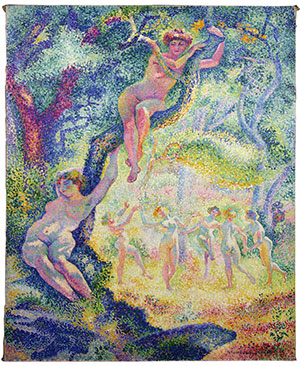Brief Report
This large painting, depicting a sunlit clearing in which naked women are dancing a reel, is one of Cross’s major works (fig. 1). More than ten extant drawings and a total of five oil studies for this work are believed to exist [Compin 1964, p. 272-275]. Of these, four studies on paper (present whereabouts unknown) in blue pencil and bistre are said to represent the whole composition. One of these drawings, according to details in the catalogue raisonné, has a grid and could also, in view of the fact that its proportions match those of the painting, have served as a pattern for transferring the composition to the canvas [Compin 1964, p. 272].
Interestingly, drawn lines similar in colour to those used for the preliminary works (blue pencil and bistre) were also used for the markings and lines for the lay-in of the grid on the primed canvas. The grid, whose lines are not at uniform intervals, is based on blue markings at the edges, and was itself drawn by Cross with a reddish-brown pencil (fig. 8), after (presumably himself) giving the canvas, already pre-primed in yellowish-white, an additional ground in pure white. Cross outlined the individual motifs and shapes of the composition in black pencil or charcoal (fig. 3).
The subsequent applications of paint were executed at first in thin layers with flourishes of the brush, and then in individual short brush-strokes or dabs. As work proceeded, he changed colours often and also made numerous corrections, and the paint applications became increasingly impasto (figs. 9, 10). The arrangement of the individual dabs or strokes of paint often underlines the form of the motif. In addition to pure colours and homogeneous blends, individual brush-strokes bear witness to the fact that Cross also loaded his brush with two different colours in such a way that they only mixed when he applied them to the canvas (fig. 11).
In places there are traces of drips of paint, which could indicate either that he tried to transport too much paint, or that his working manner was impulsive. Variations between matt and gloss on the unvarnished surface of the paint-layer point to the fact that the paints he used differed in their binder content. Individual applications of paint, particularly blue paint, are often characterized by both early shrinkage cracks and a marked network of cracks caused by aging (fig. 12). Here, as in many other places, we can see a lack of adequate adhesion between individual paint-layers as well as between the bottom paint-layer and the ground.
Henri Edmond Cross
born on 20 May 1856 in Douai,
died 16 May 1910 in Saint-Clair (Var)
Further illustrations:
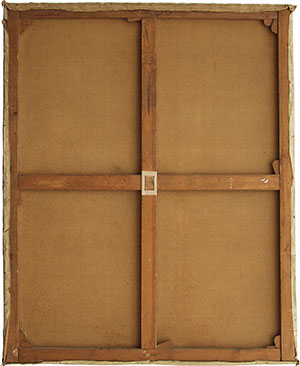
Fig. 02
Verso
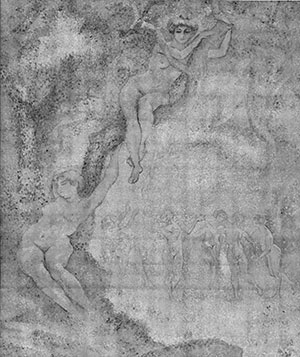
Fig. 03
Infra-red reflectogram
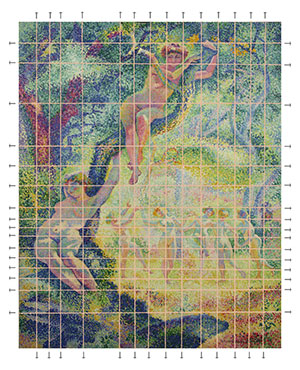
Fig. 04
Recto with mapping of the grid and the blue pencil markings for the nails to stretch the threads

Fig. 05
Detail, signature, bottom right

Fig. 06
Detail, paper sticker with indication of size and trademark of the Parisian company Bourgeois
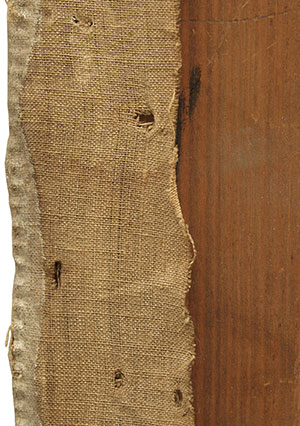
Fig. 07
Detail, top foldover edge of canvas with edge of ground and toothlike impressions of stretching pliers
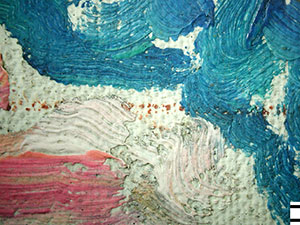
Fig. 08
Brown line of the drawn grid, microscopic photograph (M = 1 mm)
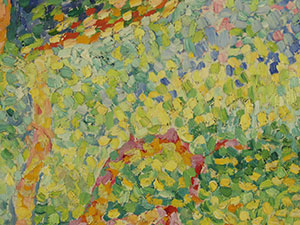
Fig. 09
Detail, centre of picture with dense application of short brush-strokes

Fig. 10
Detail (as in fig. 9), centre of picture in raking light with
increasingly impasto brush-strokes in the top layers

Fig. 11
Blend of white and green paint only mixed when applied to the canvas, microscopic photograph (M = 1 mm)

Fig. 12
Crack formation with visible losses in blue paint applications, microscopic photograph (M = 1 mm)
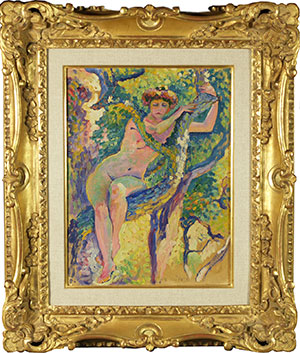
Fig. 13
Henri Edmond Cross Woman in Tree (Study to The Clearing), c. 1906, oil on paper on canvas, h 35.1 x b 27.0 cm, WRM Dep. 854

